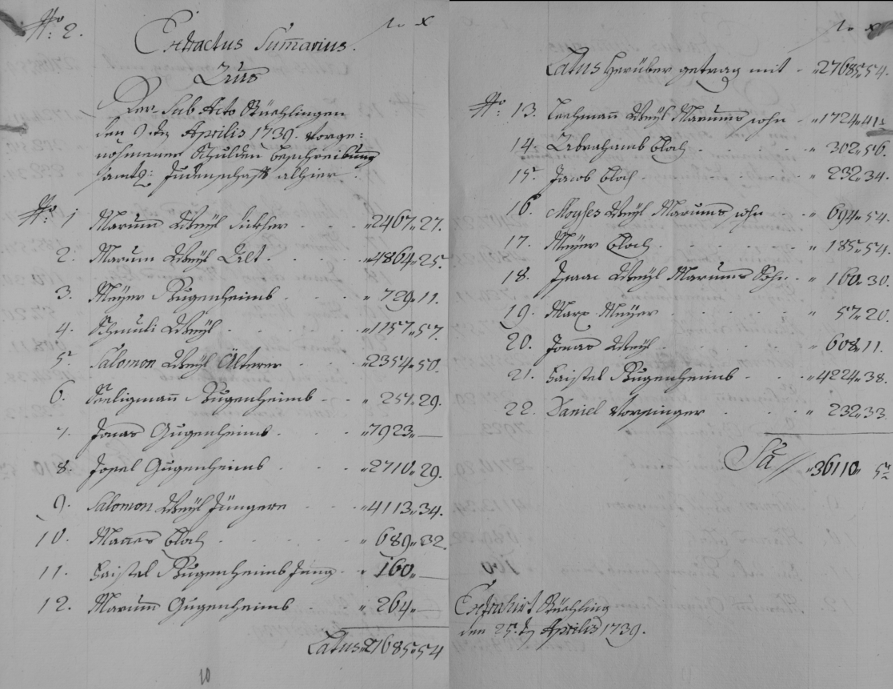12-3
¶ 1
Leave a comment on paragraph 1 0
We have some indirect clues as to what awaited evicted Jews: Young Moyses Bloch (C2.1.2.1.1.2), Menke’s son, was reported deceased three years after his eviction [R1158]. Schmule (G1.2.1.4) Gugenheimb, Seligmann’s son, last paid his protection tax in 1717 [R542] and was no longer listed among protected Jews thereafter. Four years later, Schmuli’s brother-in-law appeared in Stühlingen and accused his nephew Lang Jossel (G1.2.1.4.1):
‘of not supporting his father and his mother, who are to move about in the country in deepest poverty for considerable time’ [R3061].
Thus, losing one’s protected status appears to have constituted an existential threat to wellbeing, health, and life; and earning sufficient income to pay one’s taxes was a necessary, though not sufficient, safeguard against losing protection.
¶ 2 Leave a comment on paragraph 2 0 The controversy surrounding the 1717 renewal of protection should have served as a warning, and some of the more strategic-thinking Jews heeded the signal. Some seventeen families left over the next five years, some of them voluntarily. We do not know how many could find protection elsewhere, but they probably preferred to plan their own moment of departure. The extended Bernheimb family found protection in Tiengen [R546]. Daniel Bickert left for Wangen [R542]. Mayr Bloch (C2.1.4.2.2) had moved to Gailingen [R2964].
¶ 3 Leave a comment on paragraph 3 0 The pressure against the Jews mounted. First the monastery of St. Blasien, then the city of Schaffhausen indicated that they would no longer permit Stühlingen Jews to trade in their territories. Apart from the fact that the population resented the burden of accumulated debts, they probably felt that they now could run their market economy without the Jews. By 1738 it had become clear that the letters of protection would lapse in 1743. In order to ensure a smooth transition, the chief Fürstenberg administrator Michel ordered an official assessment of all moneys owed to the Jews. Each debt was to be examined.15 The resulting list, dated April 25, 1739, is preserved in two pages in the Donaueschingen archives under the title “Extractus summarius”, penned in beautiful chancellery script (see fig. 14):16
| Jew | Amount (fl.) |
| Marum Weyl, Dicker | 2467.27 |
| Marum Weyl, Alt | 4864.25 |
| Meyer Gugenheimb | 729.11 |
| Schmuly Weyl | 1157.57 |
| Salomon Weyl, Aelterer | 2354.50 |
| Seligman Gugenheimb | 257.29 |
| Jonas Gugenheimb | 7923.00 |
| Josel Gugenheimb | 2710.29 |
| Salomon Weyl, Jüngere | 4113.34 |
| Manes Bloch | 689.32 |
| Faistel Gugenheimb, Jung | 160.00 |
| Marum Gugenheim | 264.00 |
| Lehman Weyl, Marums Sohn | 1724.21 |
| Abraham Bloch | 302.65 |
| Jacob Bloch | 232.34 |
| Moyses Weyl, Marums Sohn | 694.54 |
| Meyer Bloch | 185.54 |
| Isac Weyl, Marums Sohn | 160.30 |
| Marx Meyer | 57.20 |
| Faistel Gugenheimb | 4224.38 |
| Daniel Vorsinger | 232.33 |
¶ 4
Leave a comment on paragraph 4 0
 Figure 14. Extractus Summarius (FFA, Judenakte)
Figure 14. Extractus Summarius (FFA, Judenakte)
15FFA, Judenakte, div. I, subdiv. 2, “Extractus summarius.”
16Rosenthal, “Heimatgeschichte der badischen Juden, 181.

Comments
0 Comments on the whole Page
Login to leave a comment on the whole Page
0 Comments on paragraph 1
Login to leave a comment on paragraph 1
0 Comments on paragraph 2
Login to leave a comment on paragraph 2
0 Comments on paragraph 3
Login to leave a comment on paragraph 3
0 Comments on paragraph 4
Login to leave a comment on paragraph 4
0 Comments on paragraph 5
Login to leave a comment on paragraph 5
0 Comments on paragraph 6
Login to leave a comment on paragraph 6